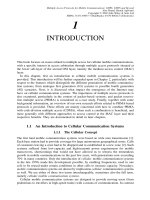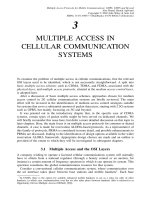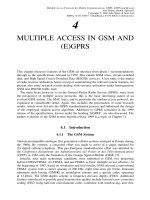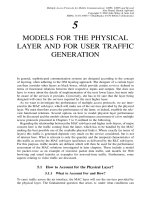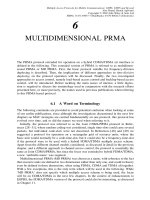Nhiều giao thức truy cập đối với truyền thông di động P1
Bạn đang xem bản rút gọn của tài liệu. Xem và tải ngay bản đầy đủ của tài liệu tại đây (179.89 KB, 22 trang )
Multiple Access Protocols for Mobile Communications: GPRS, UMTS and Beyond
Alex Brand, Hamid Aghvami
Copyright
2002 John Wiley & Sons Ltd
ISBNs: 0-471-49877-7 (Hardback); 0-470-84622-4 (Electronic)
1
INTRODUCTION
This book focuses on issues related to multiple access for cellular mobile communications,
with a specific interest in access arbitration through multiple access protocols situated at
the lower sub-layer of the second OSI layer, namely the medium access control (MAC)
layer.
In this chapter, first an introduction to cellular mobile communication systems is
provided. This introduction will be further expanded upon in Chapter 2, particularly with
respect to the features which distinguish the different generations of mobile communica-
tion systems, from analogue first generation (1G) systems to possible fourth generation
(4G) scenarios. Next, it is discussed what impact the emergence of the Internet may
have on cellular communication systems. The importance of multiple access protocols is
also examined, particularly in the context of packet-based systems, and packet reserva-
tion multiple access (PRMA) is considered as a case study. Finally, together with some
background information, an overview of our own research efforts related to PRMA-based
protocols is provided. These efforts are mainly concerned with how to combine PRMA
with code-division multiple access (CDMA), when such a combination is beneficial, and
more generally with different approaches to access control at the MAC layer and their
respective benefits. They are documented in detail in later chapters.
1.1 An Introduction to Cellular Communication Systems
1.1.1 The Cellular Concept
The first land mobile communication systems were based on wide area transmission [1].
Each base station had to provide coverage for large autonomous geographical zones. Calls
of customers leaving a zone had to be dropped and re-established in a new zone [2]. Such
systems suffered from low-capacity and high-transmit power requirements for mobile
transceivers, shortcomings that would not have allowed us to witness the tremendous
growth in mobile communications in the past few years, with penetrations now exceeding
70% in many countries. Only the introduction of cellular mobile communication systems
in the late 1970s made this development possible, by enabling frequencies, used in one
cell, to be reused under certain conditions in other cells to increase capacity. Nowadays,
mobile communication systems are almost by implication cellular communication systems
as well. We use either of these two terms interchangeably, sometimes also the full term,
namely cellular mobile communication systems.
Cellular mobile communication systems are designed to provide moving users (from
pedestrians to travellers in high-speed trains) with a means of communication. In contrast
2
1 INTRODUCTION
to (basic) cordless telephones, cellular telephones (also referred to as mobile phones,
mobile stations, mobile terminals or sometimes simply handsets) are not attached to a
particular base station, but may make use of any one of the base stations provided by
the company that operates the corresponding network. Each of these base stations covers
a particular area of the landscape, called a cell. The ensemble of base stations should
cover the landscape in such a way that the user can travel around and carry on a phone
call without interruption, possibly making use of more than one base station, as shown in
Figure 1.1. The procedure of changing a base station at cell boundaries is called handover
or handoff. We prefer the first term, since it implies (unlike the second term) that an effort
is made to sustain a call across cell boundaries. Obviously, these systems can also serve
stationary users, and do so increasingly, as fixed telephones are more and more substituted
by wireless phones.
Communication from the mobile station (MS) to the base station (BS) takes place on
the uplink channel or reverse link andfromBStoMSonthedownlink channel or forward
link (Figure 1.1). To enable communication, some resources need to be allocated to the
base station (these may be frequency bands, time-slots, sets of codes, or any combination
of the three), which in turn may assign a portion of them to individual calls to support
communication on both uplink and downlink channels. The amount of resources allocated
to users will depend on the current resource availability and the particular requirements
of each requesting user. As the base station must be able to assign individual portions of
its resources to support multiple communications, basic multiple access techniques (such
as frequency-, time-, or code-division multiple access, with FDMA, TDMA, and CDMA
as their respective acronyms) are required together with multiple access protocols,which
govern access to these resources. The basic multiple access schemes are briefly described
further below in this section, and the importance of the multiple access protocols is
examined in Section 1.3.
1.1.2 Propagation Phenomena in Cellular Communications
The design of cellular communication systems is particularly challenging because of the
adverse propagation conditions experienced on the radio channel. Without discussing the
complex underlying physical mechanisms, for which the reader may consult a mobile
communications handbook such as that in Reference [3] or a book dedicated to radio
BS
(a) (b)
Handover
Cell
Uplink
Downlink
Figure 1.1 (a) Basic principle of cellular communications. (b) Uplink and downlink channel
1.1 AN INTRODUCTION TO CELLULAR COMMUNICATION SYSTEMS
3
propagation such as that in Reference [4], three main propagation effects are usually
distinguished. These are the pathloss, slow fading or shadowing, and fast fading or multi-
path fading. The pathloss describes the average signal attenuation as a function of the
distance between transmitter and receiver, which includes the free-space attenuation as one
component, but also other factors come into play in cellular communications, resulting
in an environment-dependent pathloss behaviour. Shadowing or slow fading describes
slow signal fluctuations, which are typically caused by large structures, such as big build-
ings, obstructing the propagation paths. Fast or multipath fading is caused by the fact
that signals propagate from transmitter to receiver through multiple paths, which can add
at the receiver constructively or destructively depending on the relative signal phases.
The received signal is said to be in a deep fade when the paths add destructively in a
manner that the received signal level is close to zero. Fades occur roughly once every
half wavelength [3]. Given that we are dealing with wavelengths of 30 cm and less in
cellular communication systems, it is clear that multipath fading can result in relatively
fast signal fluctuations; exactly how fast depends on the speed of the mobile station and
on the dynamics of the surrounding environment.
When designing cellular communication systems and particularly when planning the
deployment of such systems (e.g. choosing suitable base station locations), one will
have to account for these propagation phenomena appropriately. One way to do this
is to use deterministic propagation tools such as ray tracing tools, which will calcu-
late experienced signal levels for every specific location of the planned system coverage
area, taking into account every structure which could affect signal levels. Another way
is to resort to statistical models, which have to be established by analysing propaga-
tion measurements performed in suitably chosen environments, e.g. classified as dense
urban, typical urban, suburban and rural propagation environments, to name just a few.
For the purposes of some of our investigations, we will deal with distance-independent
pathloss coefficients and a so-called lognormal shadowing model, as outlined in detail in
Chapter 5.
1.1.3 Basic Multiple Access Schemes
For reasons discussed in detail in Chapter 3, we make a distinction between basic multiple
access schemes, such as FDMA, TDMA, and CDMA, associated with the physical layer
(PHY) on the air interface of a mobile communications system, and multiple access
protocols, situated at the medium access control (MAC) layer above the PHY. Roughly
speaking, the basic schemes provide the capability of dividing the total resources available
to a base station into individual portions, which can be assigned to different users, and
the protocols govern access to these resource portions, e.g. provide access arbitration.
Analogue first generation cellular communication systems made use of FDMA as a basic
multiple access scheme. In digital 2G systems, TDMA is predominant, but a CDMA-based
system exists as well. CDMA is the most commonly used form of multiple access for third
generation systems, in some cases complemented by a hybrid CDMA/TDMA scheme.
1.1.3.1 Frequency-Division Multiple Access
In FDMA, each communication is carried over one or two (depending on the duplex
scheme, see below) narrowband frequency channels. The channel bandwidth and the
modulation scheme determine the gross bit-rate that can be sustained. Because of non-ideal
4
1 INTRODUCTION
3214
Channel bandwidth
Guard band
Frequency
Figure 1.2 FDMA channels and guard bands
. . . . . .n1234 n1234 . . .
Frame duration
Slot duration
Time
Figure 1.3 TDMA frames, time-slots, and bursts
filters, guard bands must be introduced between these channels to avoid so-called adjacent
channel interference. This is illustrated in Figure 1.2.
1.1.3.2 Time-Division Multiple Access
In TDMA, rather than assigning each user a channel with its own frequency, users share
a channel of a wider bandwidth, which we shall call a (frequency) carrier, in the time
domain. This is achieved by introducing a framing structure with each TDMA frame
subdivided into N time-slots,ifN user channels are to be supported. User i is then
allowed to access the carrier only during time-slot i, by transmitting a so-called burst
which fits into this time-slot, as shown in Figure 1.3. In order to sustain a continuous
gross source bit-rate of R
s
bit/s, the transmission speed during the burst transmission must
be at least NR
s
bit/s.
Provided that enough spectrum is available, multiple carriers may be assigned to each
cell. Therefore, such TDMA systems feature typically also an FDMA element, and are in
reality hybrid TDMA/FDMA systems.
1.1.3.3 Code-Division Multiple Access
In CDMA, narrowband signals are transformed through spectrum spreading into signals
with a wider bandwidth, the carrier bandwidth. Like in TDMA, multiple users share
the carrier bandwidth, but like in FDMA, they transmit continuously during the call or
session. The multiple access capability derives from the use of different spreading codes
for individual users. Because of the spreading of the spectrum, CDMA systems are also
referred to as spread spectrum multiple access (SSMA) systems.
Two basic CDMA techniques suitable for mobile communications are distinguished,
namely frequency hopping (FH) and direct-sequence (DS) CDMA techniques. ‘Proper’
FH/CDMA systems have not been specified for mobile communications so far and are not
discussed any further, but so-called slow frequency hopping (SFH) can also be applied
in TDMA systems. The second generation Global System for Mobile Communications
1.1 AN INTRODUCTION TO CELLULAR COMMUNICATION SYSTEMS
5
(GSM) for instance features an SFH option, the benefits of which are discussed extensively
in Chapter 4.
For one 2G system called cdmaOne and most 3G systems, e.g. the Universal Mobile
Telecommunications System (UMTS), DS/CDMA was chosen as a basic multiple access
scheme. In DS/CDMA, a bit-stream is multiplied by a direct sequence or spreading code
composed of individual chips. They have a much shorter duration than the bits of the
user bit-stream, and this is why the original signal’s spectrum is spread. The bandwidth
expansion factor, often simply referred to as spreading factor and in this book denoted
by the symbol X, is equal to the duration of a bit, T
b
, divided by the duration of a chip,
T
c
,i.e.X = T
b
/T
c
.
The same codes used at the transmitting side to spread the signals are used at the
receiving side to de-spread them again. If codes assigned to different signals or user
channels are mutually orthogonal, then these signals can be perfectly separated at the
receiving side. In practise, due to multipath propagation, fully orthogonal separation at the
receiving side may not be achieved even when the codes are orthogonal at the transmitting
side. Provided that appropriate measures are taken, this is not really a problem, but it has an
interesting consequence, which is highly relevant for some of the topics discussed in this
book. Non-orthogonality creates mutual interference between all users, so-called multiple
access interference (MAI). The resource assigned to an individual user in a CDMA system
is therefore not so much a code, but rather a certain power level. This is illustrated in
Figure 1.4, which shows sharing of resources in the time-domain, the frequency-domain,
and in terms of power levels, for FDMA, TDMA and CDMA respectively.
1.1.3.4 Frequency-Division Duplex and Time-Division Duplex
To sustain a bi-directional communication between a mobile terminal and a base station,
transmission resources must be provided both in the uplink and downlink directions.
This can either happen through frequency-division duplex (FDD), whereby uplink and
downlink channels are assigned on separate frequencies, or through time-division duplex
Power Power
Power
Time
Time
Time
FDMA
TDMA
CDMA
Frequency
Frequency
Frequency
Figure 1.4 Sharing of time-, frequency- and power resources between three users in FDMA,
TDMA and CDMA respectively
6
1 INTRODUCTION
(TDD), where uplink and downlink transmissions occur on the same frequency, but alter-
nate in time. Both methods can be applied in conjunction with any of the above-described
multiple access schemes. 1G and 2G systems apply FDD. In UMTS, a 3G system, both
FDD and TDD modes are supported, not least because symmetric uplink and downlink
spectrum is normally required for FDD-only systems, but 3G spectrum consists of both
so-called paired bands (i.e. symmetric spectrum) and unpaired bands.
A description of the key features of 1G, 2G and 3G systems is provided in Chapter 2,
which also considers possible 4G scenarios. Advantages and disadvantages of the different
basic multiple access schemes are examined in more detail in Section 3.2. Approaches
to the modelling of the physical layer performance for some of our investigations are
discussed in Chapter 5. Chapter 4 on multiple access in GSM and GPRS deals also to
quite a considerable extent with physical layer issues.
1.1.4 Cell Clusters, Reuse Factor and Reuse Efficiency
As pointed out earlier, resources used in one cell may be reused in other cells, but
this must be done in such a way that ongoing communications experience sufficient
quality. Assume for now that we are dealing with frequency resources, and that the main
factor affecting the quality is the so-called co-channel interference, that is, interference
generated by communications in other cells transmitting on the same frequency as a
desired communication link in a test cell. The required communication quality, together
with other factors, e.g. related to propagation conditions, such as the pathloss coefficient,
will determine the minimum distance that must be respected between two co-channel
cells, the so-called reuse distance. This leads to the concept of cell clusters (or cellular
reuse patterns), namely a set of neighbouring cells within the reuse distance, any two
of which are not allowed to use the same frequency. The frequencies are instead reused
in a cell occupying the same relative position in a neighbouring cluster, as illustrated in
Figure 1.5. In other words, every cell in a cluster obtains a share of the total bandwidth
available to an operator, and the same bandwidth is reused in other clusters. The number
of cells within each cluster is called the (frequency) reuse factor or cluster size N
f
[5],
which is seven in the example depicted. The reuse efficiency is the inverse of the reuse
factor, hence 1/N
f
.
With such a cellular approach, it is in theory possible to increase capacity without limit
through cell splitting (i.e. deploying multiple small cells in an area previously served by
a single big one), but there are certain practical constraints.
1.1.5 Types of Interference and Noise Affecting Communications
The permitted co-channel interference, which depends on various physical layer aspects
such as the modulation scheme employed, is a key parameter determining the minimum
frequency reuse factor. Communications taking place on adjacent channels can also create
notable mutual interference because of non-ideal filters both at the transmit side (resulting
in some power being also radiated outside the allocated channel) and at the receive side
(due to receive filters not fully rejecting out-of-band signals). This is referred to as adjacent
channel interference (ACI). It is strongest between directly adjacent or neighbouring
channels, and decreases as channels further apart are being considered owing to the filter
1.1 AN INTRODUCTION TO CELLULAR COMMUNICATION SYSTEMS
7
1
1
6
2
21
2
3
3
3
4
4
5
5
5
7
6
67
7
4
D
Reuse distance
Cell radius
R
Figure 1.5 Cell clusters assuming hexagonal cells with a frequency reuse factor of seven
attenuation. In general, ACI is much less of a problem than co-channel interference. All the
same, when several frequency channels are assigned to a cell, if they are neighbouring
channels, guard bands should separate them to avoid excessive ACI, otherwise non-
neighbouring channels should be assigned. Unfortunately, due to limited 3G spectrum
and the fact that wideband channels are used, there are 3G scenarios for such systems
where neither sufficient guard band is available nor non-neighbouring channels can be
chosen, hence ACI becomes an issue, as discussed in Section 2.3.
Compared to TDMA and FDMA systems, CDMA systems exhibit certain peculiarities.
Firstly, the reuse factor can be set to one in CDMA systems (and in fact often is).
This is also referred to as universal frequency reuse. In this case, mutual interference is
generated between all cells, hence rather than referring to this as co-channel interference,
the term intercell interference is used. Secondly, while user channels within a cell are
separated from each other in an orthogonal manner both in TDMA systems (perfect
separation between time-slots can be achieved through guard periods) and in FDMA
systems (assuming sufficient guard bands to avoid ACI), this is not necessarily the case
in CDMA systems. Since spreading codes do not always provide orthogonal separation,
interference within a cell, so-called intracell interference, can become an issue as well.
Therefore, intracell and intercell interference can both be non-negligible components of
the total multiple access interference experienced by a communication link in a CDMA
system.
On top of interference generated by other users in the system, additional noise sources
may affect the quality of a communication, for instance thermal noise. In the following,
the term ‘interference’ refers to noise generated by other cellular users, and ‘noise’ to
thermal noise as well as noise generated by sources outside the considered system. The
communication quality in terms of bit error rate (BER) or frame erasure rate (FER) can
therefore be expressed as a function of the signal-to-noise ratio (SNR), or the signal-
to-interference ratio (SIR), depending on which type of signal disturbance is dominant.
Typically, at the beginning of a system build out, when there are few cells, the system is
8
1 INTRODUCTION
coverage-limited, and the SNR is mostly relevant. As cells are added to fill in coverage
holes and reduce cell radii, and the user traffic increases, the system becomes capacity-
limited and the SIR becomes more critical. In situations where neither interference nor
noise can be ignored, the signal-to-interference-plus-noise ratio (SINR) may be considered
as a channel measure. However, if the nature of the interference is significantly different
from that of the noise and affects the signal in a different manner, then it may not be
possible to lump the two together and describe the performance as a function of the SINR.
Instead, one would have to use, for example, SNR curves parameterised to interference
levels or SIR curves parameterised to noise levels.
The signal quality can also be expressed as a function of the ratio of energy per bit
E
b
either to the noise power per Hertz, N
0
, or the interference power per Hertz, I
0
.
Finally, instead of using signal and interference levels at the ‘base-band’, the so-called
carrier-to-interference ratio (CIR) at the radio frequency level is often used. According to
Reference [6],
CIR =
E
b
· R
b
I
0
· B
c
,(1.1)
with R
b
the bit-rate in bits per second, and B
c
the radio channel bandwidth in Hertz.
1.2 The Emergence of the Internet and its Impact on
Cellular Communications
In the ‘wired world’, we are witnessing how traffic of all types is increasingly being
carried on packet-switched networks using the connectionless internet protocol (IP) — or
rather, the IP protocol suite, which features various other protocols on top of IP, e.g.
transport protocols such as the transport control protocol (TCP) and the user datagram
protocol (UDP). This development is mainly due to the tremendous success the Internet
has enjoyed in recent years (incidentally, not unlike cellular communications). Initially
constrained to non-real-time applications such as Telnet, file transfer, email and Web
browsing, this move towards IP now embraces audio and video streaming with more
stringent delay constraints, and even ‘proper’ real-time traffic such as Voice over IP (VoIP).
Strictly speaking, it is typically voice over RTP (the real-time protocol, an application-
level protocol), UDP and IP. It is now widely anticipated that the same will eventually
happen in the wireless world as well, which has some serious technical implications on
cellular communication systems. In the following, we deal with the general implications;
the impact specifically on multiple access protocols is discussed in the next section.
Already in the late eighties (e.g. in Reference [7]), Goodman, whom we will refer to
at various other occasions in this text, suggested that both the fixed architecture and the
air interface of 3G systems should be based entirely on packet-switching for all types
of services. Not only would the available resources be exploited more efficiently, but
also certain functions could be decentralised and distributed over many processors, which
would improve the scalability of such systems. He also proposed a packet-based multiple
access protocol called packet reservation multiple access (PRMA) suitable for the wireless
links between mobile and base stations. Although his vision of an all-packet system
was probably not driven by the Internet at that time (he suggested that ‘3G systems, in
harmony with broadband integrated services digital networks, would use shared resources
